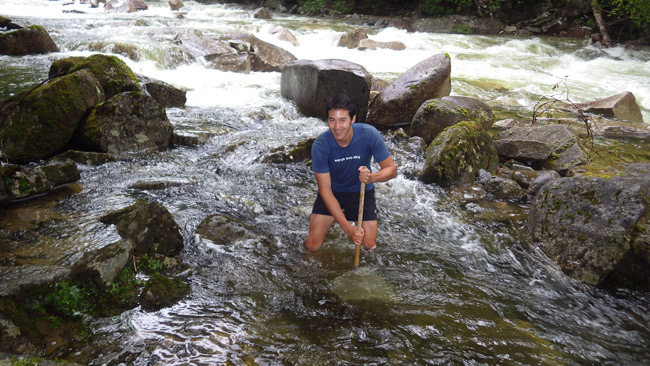Honorary Lecturer, University of Otago, New Zealand
Email jeremy.piggott@otago.ac.nz
Phone +353 1 896 1642

About
I am an Assistant Professor of Aquatic Biology in the School of Natural Sciences at Trinity College Dublin (Ireland) and Honorary Lecturer at the University of Otago. I have previously held research fellowships at the National University of Singapore (Singapore), Kyoto University (Japan), Imperial College London (UK) and Peking University (China). I currently serve as Associate Editor of the journals Limnology and Journal of Applied Ecology, Lead Author for the Intergovernmental Platform on Biodiversity and Ecosystem Services (IPBES), International Advisor to the EU funded MARS project (Managing Aquatic ecosystems and water Resources under multiple Stress), Management Committee of the EU COST Action DNAqua-NET (Developing new genetic tools for bioassessment of aquatic ecosystems in Europe), and on the FutureEarth working group on 'Biodiversity monitoring for ecosystem services' and of the British Ecological Society working group on 'Ecological resilience in science & policy'.
Research Interests
My research focuses on several topical themes in fundamental and applied ecology, including the determinants of biodiversity structure and function from genes to ecosystems, the combined influence of multiple anthropogenic stressors on communities and ecosystems, and the management and conservation of biodiversity and ecosystem services in the face of global change. I perform my research predominantly in streams and rivers, combining 'natural' field experiments with manipulative experiments at a range of scales, from whole streams to mesocosms. By advancing knowledge and connecting science to policy, my research seeks to improve the management, conservation and restoration of aquatic ecosystems in the face of global change.
Selected/Recent Publications
A full list of my publications can be found here: https://www.researchgate.net/profile/Jeremy_Piggott
- Salis R., Bruder A., Piggott J.J., Summerfield T. C. & Matthaei C.D. (2017) Next-generation sequencing and stream benthic bacteria: which taxonomic level is best for multiple-stressor research? Scientific Reports. 7, 44657.
- Hale R., Piggott J.J. & Swearer S.E. (2017) Describing and understanding behavioural responses to multiple stressors. Ecology & Evolution. 7: 38–47. DOI: 10.1002/ece3.2609
- Leese F., Altermatt F., Bouchez A., Ekrem T., Hering D., Meissner K., Mergen P., Pawlowski J., Piggott J.J., … Zimmermann J. (2016) DNAqua-Net: Developing new genetic tools for bioassessment and monitoring of aquatic ecosystems in Europe. Research Ideas and Outcomes 2: e11321. https://doi.org/10.3897/rio.2.e11321
- Jackson, M.C., Weyl, O.L.F., Altermatt, F., Durance, I.6, Friberg, N., Dumbrell, A.J., Piggott, J.J., Tiegs, S., Tockner, K., Krug, C., Leadley, P. & Woodward, G. (2016) Recommendations for the next generation of global freshwater biomonitoring tools. Advances in Ecological Research. DOI: 10.1016/bs.aecr.2016.08.008
- Taniwaki R., Piggott J.J., de Barros Ferraz S.F. & Matthaei C.D. (2016) Climate change and multiple stressors in small tropical streams. Hydrobiologia. DOI: 10.1007/s10750-016-2907-3
- Piggott J.J. (2016). Project Report: IPBES Regional Assessment of Biodiversity and Ecosystem Services for Asia and the Pacific. Towards the Zero Order Draft (ZOD). Journal of Integrated Creative Studies, No.2016-009-e.DOI: 10.14989/214433.
- Elbrecht V., Beermann A.J., Goessler G., Neumann J., Tollrian R., Wagner R., Wlecklik A., *Piggott J.J., *Matthaei C.D. & *Leese F. (2016) Multiple-stressor effects on stream invertebrates: A mesocosm experiment manipulating nutrients, fine sediment and flow. Freshwater Biology. 61, 362-375..* Equal senior authors.
- Magbanua F.S., Townsend C.R., Hageman K.J., Piggott J.J. & Matthaei C.D. (2016). Individual and combined effects of fine sediment and glyphosate herbicide on invertebrate drift and insect emergence: a stream mesocosm experiment. Freshwater Science. 35: 139–151.
- Piggott J.J., Townsend C.R. & Matthaei C.D. (2015). Climate warming and agricultural stressors interact to determine stream macroinvertebrate community dynamics. Global Change Biology. 21: 1887-1906.
- Piggott J.J., Salis R., Lear G., Townsend C.R. & Matthaei C.D. (2015). Climate warming and agricultural stressors interact to determine stream periphyton community composition. Global Change Biology. 21: 206-222. ***This paper was awarded the 2016 International Society of Limnology (SIL) early-career Award***
- Piggott J.J., Niyogi D.K., Townsend C.R. & Matthaei C.D. (2015). Multiple stressors and stream ecosystem functioning: climate warming and agricultural stressors interact to affect processing of organic matter. Journal of Applied Ecology. 52: 1126–1134.
- Piggott J.J., Townsend C.R. & Matthaei C.D. (2015). Re-conceptualizing synergism and antagonism among multiple stressors. Ecology & Evolution. 5: 1538-1547.
- Piggott J.J., Lange K., Townsend C.R. & Matthaei C.D. (2012). Multiple Stressors in Agricultural Streams: A Mesocosm Study of Interactions among Raised Water Temperature, Sediment Addition and Nutrient Enrichment. PLoS ONE, 7, e49873.
- Lange K., Liess A., Piggott J.J., Townsend C.R. & Matthaei C.D. (2011). Light, nutrients and grazing interact to determine stream diatom community composition and functional group structure. Freshwater Biology, 56, 264-278.
- Matthaei C.D., Piggott J.J. & Townsend C.R. (2010). Multiple stressors in agricultural streams: interactions among sediment addition, nutrient enrichment and water abstraction. Journal of Applied Ecology, 47, 639-649.
- Liess A., Lange K., Schulz F., Piggott J.J., Matthaei C.D. & Townsend C.R. (2009). Light, nutrients and grazing interact to determine diatom species richness via changes to productivity, nutrient state and grazer activity. Journal of Ecology, 97, 326-336.
- Mark A.F., Porter S., Piggott J.J., Michel P., Maeglp T. & Dickinson K.J.M. (2008). Altitudinal patterns of vegetation, flora, life forms, and environments in the alpine zone of the Fiord Ecological Region, New Zealand. New Zealand Journal of Botany, 46, 205-237.